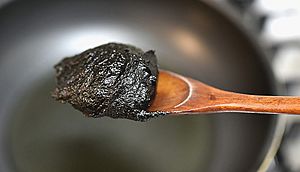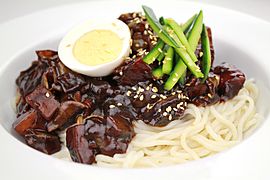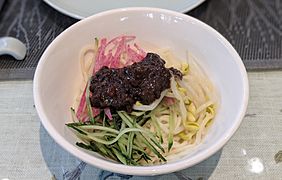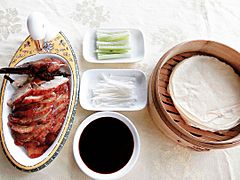Tianmian sauce facts for kids
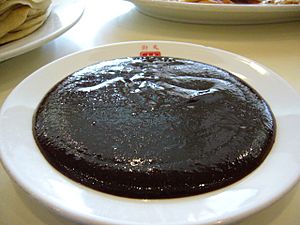
A dish of tianmian sauce
|
|
| Alternative names | Sweet flour sauce |
|---|---|
| Type | Sauce |
| Place of origin | China |
| Region or state | Northern and Northeastern China, South Korea |
| Associated national cuisine | Chinese cuisine Korean-Chinese cuisine |
| Main ingredients | Flour, salt |
| Ingredients generally used | Soybean |
| Regional names | |||||||||||||||
|---|---|---|---|---|---|---|---|---|---|---|---|---|---|---|---|
| Chinese name | |||||||||||||||
| Traditional Chinese | 甜麵醬 / 甜醬 | ||||||||||||||
| Simplified Chinese | 甜面酱 / 甜酱 | ||||||||||||||
| Literal meaning | "sweet flour sauce" / "sweet sauce" |
||||||||||||||
|
|||||||||||||||
| Korean name | |||||||||||||||
| Hangul | 춘장 | ||||||||||||||
|
|||||||||||||||
Tianmian sauce (also known as sweet bean sauce or sweet flour sauce) is a special kind of thick, dark brown, or black paste. It has a mild, savory, or sweet taste. People often use it in cooking in Northern China and Northeastern China. It is also popular in Korean-Chinese food. Famous dishes like Peking duck and jajangmyeon use this sauce.
Contents
What's in a Name?
The Chinese name for this sauce is tiánmiànjiàng (甜麵醬). It means "sweet" (甜), "flour" (麵), and "sauce" (醬). Sometimes, it is just called tiánjiàng (甜醬), which means "sweet sauce."
In Korea, the sauce is called chunjang (춘장). We do not know exactly where this name came from. One idea is that it came from the word cheomjang (첨장). This is the Korean way to say the Chinese characters 甛醬.
How Tianmian Sauce is Made
Even though it is called "sweet bean sauce," it is mostly made from wheat flour that has been fermented. Fermentation is a process where tiny living things (like yeast or bacteria) change food.
To make it, people use about 19 parts of wheat flour to one part of soybean. A special starter for fermentation is made from dried or old mantou (a type of steamed bread). This starter is wrapped in a kind of muskmelon called miangua. Then, it is tied up and hung in a cool, dark place until it is completely dry.
During the fermentation process, natural sugars like glucose and maltose are created. These sugars give the paste its special sweet taste.
Different Kinds and How They are Used
Chinese Varieties
Sweet bean sauce is similar to hoisin sauce. It is used in dishes like Peking duck. It can also be used as a sweeter choice instead of the saltier yellow soybean paste. In Northern China, people sometimes eat this sauce with raw scallions.
There are many different kinds of sweet bean sauces. How they are made can change depending on where they come from in China. It also depends on what the company making it prefers. In northern China, more sugar is often added to the sauce. In southern China, mantou flour is often used as the main ingredient instead of sugar.
Traditionally, the best sweet bean sauces get their sweet taste from the fermentation of starches. This means they do not need extra sugar added. You can find sweet bean sauce in most Asian supermarkets. In Chinese, it is written 甜面酱.
Korean Chunjang
In Korea, chunjang (춘장) is most often used to make jajang (자장). This is a black gravy that goes with a popular noodle dish called jajangmyeon. Other common dishes with jajang sauce include jajang-bap (which is rice with jajang sauce) and jajang-tteok-bokki (stir-fried rice cakes with jajang sauce).
Even though stir-frying chunjang to make jajang is the most common way to use it, chunjang can also be served with sliced raw onions. In most Korean-Chinese restaurants, raw onions, chunjang, and danmuji (yellow pickled radish) are the usual side dishes.
Korean chunjang is like the tiánmiànjiàng from Shandong in China. This is because it was first used in Incheon Chinatown. Most of the restaurants there were run by Chinese people who came from Shandong. However, today, most Korean-Chinese restaurants are run by Koreans. So, chunjang has changed to fit Korean tastes, just like other Korean-Chinese dishes and ingredients.
Gallery
-
Peking duck is often served with Tianmian sauce.
-
Jajangmyeon is a popular Korean-Chinese noodle dish with chunjang.
-
Korean-Chinese bokkeum-bap (fried rice) can also use jajang sauce.
-
Onion, danmuji, and chunjang are common side dishes in Korean-Chinese restaurants.
-
Zhajiangmian is a Chinese noodle dish similar to jajangmyeon.
See also
 In Spanish: Salsa de judía dulce para niños
In Spanish: Salsa de judía dulce para niños


